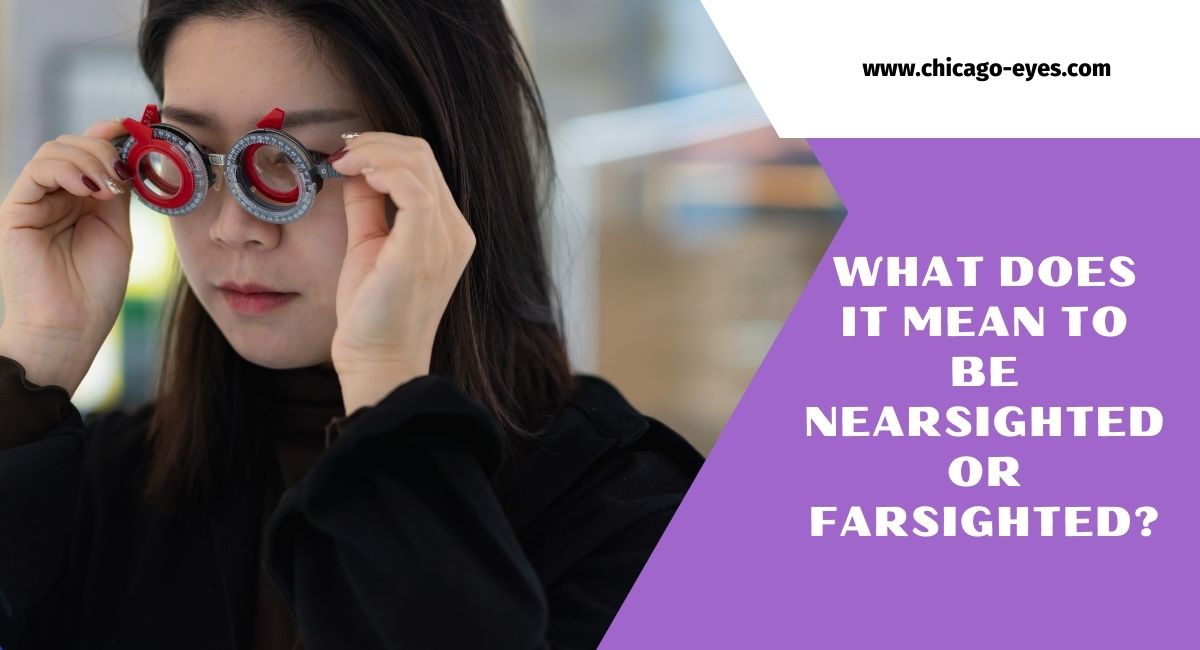Normal vision is achieved when light is focused squarely on the retina instead of in front of or behind it. Both close-up and distant things are visible to someone with normal eyesight.
Most visual impairments are caused by nearsightedness, farsightedness, astigmatism, or a mix of the three.
Recalling the distinctions between nearsightedness and farsightedness can be challenging.
To put it briefly, nearsightedness is the capacity to see objects close by relatively clearly, but farsightedness is limited to seeing only distant objects with great clarity.
When a visual picture is focused in front of the retina instead of directly on it, nearsightedness causes blurry vision. It happens when the eye’s actual length is longer than its optical length.
When a visual picture is focused behind the retina instead of directly on it, farsightedness results. It could be caused by an undersized eyeball or insufficient focusing strength.
How Can I determine My Nearsightedness Or Farsightedness?
Try testing which objects in your field of vision are the blurriest to determine if you are nearsighted or farsighted.
Before anything else, turn away from displays or close them for a short while to refresh your eyes.
Next, attempt to read a few pages from a book. Do the words appear hazy? Do you still have a headache from it? You may have a long sight.
Now try focusing on anything far away, like a wall poster or a street sign, from a distance of roughly ten feet. Do words and shapes not appear clear enough to read or recognize them? You may be nearsighted.
You are likely both nearsighted and farsighted if you have trouble seeing close and far objects. When each of your eyes develops a unique ailment, this is what can happen. In actuality, each eye might have differing degrees of nearsightedness or farsightedness.
Make an appointment with an optometrist for an eye checking if you think you may be nearsighted or farsighted so you may receive treatment and have the diagnosis confirmed.
Nearsightedness
The condition known as nearsightedness is characterized by the ability to see close items clearly but trouble seeing distant objects. Another name for it is myopia.
Reasons
Our eyes translate light into images, which aids with seeing. Light enters our eyes through the cornea, passes through the pupil, and then returns to the retina.
The optic nerve receives light from the retina and then transmits signals to the brain. A refractive defect associated with nearsightedness results in improper focus of light on the retina.
Variations in the shape of the eye cause refractive errors. You may be born with an overly rounded cornea or an overly lengthy eyeball, or these new forms may evolve as you mature and expand.
Signs And Symptoms
The primary sign of nearsightedness is blurriness when attempting to perceive distant objects. For instance, one might struggle to see traffic signs while driving or have problems seeing writings on a school whiteboard.
- The strain of constantly having to force your eyes to focus during the day may cause you to experience the following additional symptoms:
headaches - squinting
- eye strain or discomfort
Farsightedness
Hyperopia, another name for farsightedness, is when you have trouble seeing close items clearly but can clearly see faraway objects.
Reasons
The shape of the eye also plays a role in farsightedness. The components of the eye that refract incoming light into the retina are the cornea and lens. After the retina absorbs light, it transfers the information to the optic nerve, sending it to the brain.
Flat corneas or shorter eyeballs indicate farsightedness.You most likely inherited this condition from your parents.
Signs And Symptoms
- Farsighted people may find it difficult to read and may also encounter the following issues:
narrowing - hurting, scorching, or agony surrounding the eyes
- Headaches that are unique to reading or other activities that need you to concentrate on close things
Is Astigmatism Connected To Visual Acuity?
Astigmatism is another typical vision issue brought on by an imperfection in the shape of the eye.
Astigmatism is characterized by an uneven curvature of the cornea or lens of the eye. Like nearsightedness and farsightedness, the irregular curve modifies how light enters the retina through refractive error.
When the brain processes the information from the ocular nerve, the images you see become blurry.
Since astigmatism is not linked to blurriness of vision at a particular distance, it differs from nearsightedness and farsightedness. Instead, astigmatism may factor in a wider range of visual impairments.
Astigmatism, in contrast to myopia and hyperopia, can result from eye trauma or surgical procedures.
How Are The Illnesses Identified And Treated?
See an eye care specialist if you frequently have hazy vision.
Nearsightedness
Visual acuity examinations are used to diagnose nearsightedness. On these assessments, you must read letters from a chart at a set distance.
If a diagnosis is made, additional tests will be necessary to establish the course of treatment.
Foresightness
As was already noted, mild to low cases of farsightedness might be challenging to diagnose.
The majority of instances can be identified by a refraction assessment and an eye health examination, which may involve pupil dilation.
Astigmatic
Refraction, keratometry, and visual acuity tests can all be used to identify astigmatism.
The ability to see objects up close is known as nearsightedness, and the ability to see objects far out is known as farsightedness. Both nearsightedness and farsightedness may be exacerbated by astigmatism, which can occur in one eye alone.
If you believe you may have visual issues, get a professional evaluation from an optometrist or ophthalmologist. Your symptoms should be manageable with contacts, glasses, or surgery.
Eat well-balanced diets, keep yourself physically active, and shield your eyes from the elements to help preserve eye health as you age.
Read More: Can Eye Makeup Cause Eye Problems?
